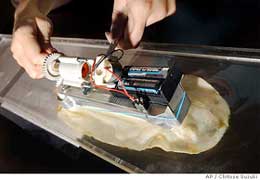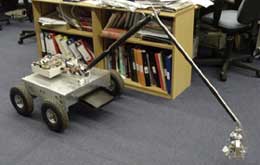MIT engineers, led by Anette Hosoi, have built a robotic snail to test out mathematical models of how snails move and stay stuck to surfaces.
The artificial gastropod has five movable segments lined up on its underside. One by one, each of these sections moves forwards along a track on the robot’s body. After all five have advanced, the body itself slides forward, returning the segments to their original positions.

The team tested out their snail on a tilting platform, covered with slime made from Laponite, a type of clay that forms a clear, sticky gel when mixed with water. Even when the platform was flipped over so that the robot was upside down, it still made steady progress.
Because gastropods have only one foot, it is much easier to build mechanical analogues of snails than of two-footed people or four-footed animals. And although they are slow, snails can crawl around different environments.
The team is now working on a second generation of robosnails that are much faster and more manoeuvrable.
Via robot gossip nature.
Image.
The Intelligent Autonomous Systems Laboratory developed in 2001 the SlugBot, a proof-of-concept vehicle that detects, collects and snacks on slugs.

The researchers’ aim was to “feed” the robot with the slug it collected, they would be fermented to produce biogas in a digester unit. The gas would then be passed through methane fuel cell to generate electricity. The electricity would be stored in batteries and could be downloaded to a ‘hungry’ robot.
The prototype can move, scan, detect and almost collect slugs whilst ignoring stones.
Video 1 and 2 (no animals were harmed during these experiments – the slug is plastic!).
Via Vie Artificielle.
